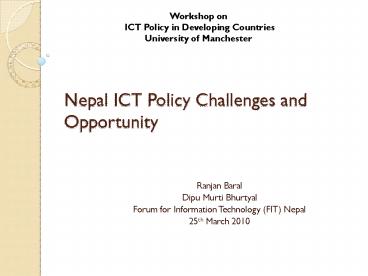Nepal ICT Policy Challenges and Opportunity - PowerPoint PPT Presentation
1 / 16
Title:
Nepal ICT Policy Challenges and Opportunity
Description:
Workshop on ICT Policy in Developing Countries University of Manchester Nepal ICT Policy Challenges and Opportunity Ranjan Baral Dipu Murti Bhurtyal – PowerPoint PPT presentation
Number of Views:224
Avg rating:3.0/5.0
Title: Nepal ICT Policy Challenges and Opportunity
1
Nepal ICT Policy Challenges and Opportunity
Workshop on ICT Policy in Developing
Countries University of Manchester
- Ranjan Baral
- Dipu Murti Bhurtyal
- Forum for Information Technology (FIT) Nepal
- 25th March 2010
2
Overview
- Background
- Policy Action Plan
- Key Indicators
- Policy Action Plan vs. Results
- ICT in Development Context
- Challenges
- Outcomes
- Evaluation
- Recommendation
3
Background
- IT policy 2000
- Place Nepal on global IT map
- Make IT accessible to general public, creation of
knowledge based society/industries - Telecommunication Policy 2004
- To create favourable environment to make the
telecommunication service reliable and accessible - eGovernment Master Plan 2005
- Electronic Transaction act 2008
- ADB supported ICT Development Project
4
Policy Action Plan
5
Indicators
Teledensity 27.15 Fixed Line 2.98
Mobile 23.22 Limited Mobility
0.95 Internet Subscriber 1,34,014 Internet User
1,34,014 4 Adult Literacy 56.5 Source
Nepal Telecommunication Authority,
UN eGov Survey
2005 2008 2010
Ranking 126 150 153
E-Readiness 0.3021 0.2725 0.2568
Web Measure Index 0.4000 0.2876 0.1683
Human Capital Index 0.500 0.5176 0.5820
Infrastructure Index 0.0063 0.0119 0.0226
E-Participation Index 0.0794 0.0227 0.0572
Source United Nations E-Government Development
Knowledge Base
6
Policy Action Plan vs. Result
Action Result
An IT park establishment and special incentive to company established on the park including provision of 100 foreign investment in IT enabled Industry IT park established. No adequate infrastructure in park.
An internet node at every district with info-super highway and north-south info-highway Basic telecommunication services reached to every district. Internet expansion should focused.
On demand telecommunication/electricity shall be provided to IT entrepreneur Nepal facing critical power shortage. Power cut for 12 hrs/day in capital on its peak.
Capacity Enhancement of University college providing IT courses. Program on computer education to all by 2010 A.D. No program in supporting ICT education for college. However, private colleges developed their capacity on their own. Only few public School provides computer education.
Free Internet to University and Public school No work carried out.
Web site for all Government offices Most of the central level office only have basic web presence.
Venture capital establishment with govt. 100 million investment No initiatives by Government.
Institutional arrangements Established NITC and HLCIT but overlapping roles problems for proper implementation. Electronic transaction act decl
IT policy shall be revised in every 2 years Not revised for 10 years. Draft presented to cabinet last month.
7
ICT in Development Context
The Onion Ring Model Source Heeks(2005)
8
Putting Key Challenges into Onion Ring Model
Political Instability
Infrastructure
Human capacity
Content
Attitude Culture
9
Challenge Tree
10
ICT Export-led Growth
- Opportunity or over-ambition?
- Nepal India comparison
- a
Factor India Nepal
Infrastructure Rail network, IT parks, high-speed broadband Power outage
Human capacity Large pool, reverse-brain-drain Small pool, brain-drain
Universities IIT leading institutions Few
English language Widely spoken Limited
Active Diaspora Entrepreneurship, FDI Very few IT-focused activity.
Brand and Global trust International clients, high-profile projects Tourism as established brand.
Government Policy Single-window system, land purchase privileges etc. Learning phase, slow decision process.
Political stability Long history of democratic practice Political strikes halt everyday life.
11
Few Good Initiatives
- Language Technology progress (MPP)
- Nepali Unicode, Dictionary
- NLP Speech recognition for Nepali language
- Localisation of Operating Systems
- Localised Information Systems
- Above progress propels the Content Development
movement, for telecentres and excluded ethnic and
minority groups. - Aids in e-Government many sectors
12
ICTs in Nepal in Development Perspective
- Place of ICT in Tenth five-year National Plan
2002-2007 and three-year interim plan. - Integrating ICT in primary contributing sectors
to GDP. - E.g. Tourism, SMEs, Agriculture
13
Recommendations
- Political leaders and top bureaucrats not aware
on dynamics and element of knowledge based
society. Training on eGovernment, eServices and
Knowledge economy. - Target beneficiaries should be involved at the
policy formulation stage ( policy always
undisclosed material before announced) - Communication between beneficiary and policy
implementers is important for monitoring
successes. - Policy itself should clearly define the proper
independent monitoring ( Important for both
implementation and corruption control). - Reduce Time lag between the policy formulation
and actual implementation. - ICT less attractive sector within government
(unless there is an opportunity of procurement of
hardware/services) . Special incentive for ICT
workforce within government.
14
Recommendations...
- Key ICT post based on political appointments.
Frequent changes in government results in change
of leadership. Key post holders always
apprehensive about their job. - Ensuring proper responsibility delegation and
accountability. People keen to delegate risk. - Most eGov and ICT4D project hardware driven. More
emphasis should be given on Process and Service
improvements thru the use of ICT. - Focus should be on Quality of Service in Telecom
sector. Capacity Building of regulatory body.
15
Bibliography
- Butt, D. (2005) Internet Governance
Asia-Pacific Perspectives, UNDP-APDIP, Bangkok. - Heeks, R. (2005). Foundations of ICTs in
Development The Onion-Ring Model. DIG
eDevelopment Briefings, No.4/2005. Manchester
Institute for Development Policy and Management.
Accessed Online Feb 28, 2010 from
http//www.sed.manchester.ac.uk/idpm/publications/
wp/di/short/DIGBriefing4Onion.doc - Heeks, R. (1999) Software strategies in
developing countries, IDPM, University of
Manchester, Manchester. - ITPF (2002) Policy Recommendation on Electronic
Transaction and Digital Signature Act (draft), IT
Professional Forum, Kathmandu, Nepal - MoEST (2006) eGovernance Master Plan, Ministry of
Environment, Science and Technology, Kathmandu - MoEST. (2000) Information Technology Policy 2000,
Ministry of Environment, Science and Technology,
Kathmandu. - Regmi, S. (2006) ICT, SMEs and Business
Development in the Nepalese Context, IT
Professional Forum, Kathmandu, ITPF - World Bank (2006) Information and Communication
for Development, Trends and Policies, World Bank,
Washington, D.C.
16
- Thank You!!!

